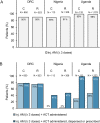Health worker compliance with severe malaria treatment guidelines in the context of implementing pre-referral rectal artesunate in the Democratic Republic of the Congo, Nigeria, and Uganda: An operational study
- PMID: 36809247
- PMCID: PMC9990943
- DOI: 10.1371/journal.pmed.1004189
Health worker compliance with severe malaria treatment guidelines in the context of implementing pre-referral rectal artesunate in the Democratic Republic of the Congo, Nigeria, and Uganda: An operational study
Erratum in
-
Correction: Health worker compliance with severe malaria treatment guidelines in the context of implementing pre-referral rectal artesunate in the Democratic Republic of the Congo, Nigeria, and Uganda: An operational study.PLoS Med. 2023 Apr 26;20(4):e1004234. doi: 10.1371/journal.pmed.1004234. eCollection 2023 Apr. PLoS Med. 2023. PMID: 37099752 Free PMC article.
Abstract
Background: For a full treatment course of severe malaria, community-administered pre-referral rectal artesunate (RAS) should be completed by post-referral treatment consisting of an injectable antimalarial and oral artemisinin-based combination therapy (ACT). This study aimed to assess compliance with this treatment recommendation in children under 5 years.
Methods and findings: This observational study accompanied the implementation of RAS in the Democratic Republic of the Congo (DRC), Nigeria, and Uganda between 2018 and 2020. Antimalarial treatment was assessed during admission in included referral health facilities (RHFs) in children under 5 with a diagnosis of severe malaria. Children were either referred from a community-based provider or directly attending the RHF. RHF data of 7,983 children was analysed for appropriateness of antimalarials; a subsample of 3,449 children was assessed additionally for dosage and method of ACT provision (treatment compliance). A parenteral antimalarial and an ACT were administered to 2.7% (28/1,051) of admitted children in Nigeria, 44.5% (1,211/2,724) in Uganda, and 50.3% (2,117/4,208) in DRC. Children receiving RAS from a community-based provider were more likely to be administered post-referral medication according to the guidelines in DRC (adjusted odds ratio (aOR) = 2.13, 95% CI 1.55 to 2.92, P < 0.001), but less likely in Uganda (aOR = 0.37, 95% CI 0.14 to 0.96, P = 0.04) adjusting for patient, provider, caregiver, and other contextual factors. While in DRC, inpatient ACT administration was common, ACTs were often prescribed at discharge in Nigeria (54.4%, 229/421) and Uganda (53.0%, 715/1,349). Study limitations include the unfeasibility to independently confirm the diagnosis of severe malaria due to the observational nature of the study.
Conclusions: Directly observed treatment was often incomplete, bearing a high risk for partial parasite clearance and disease recrudescence. Parenteral artesunate not followed up with oral ACT constitutes an artemisinin monotherapy and may favour the selection of resistant parasites. In connection with the finding that pre-referral RAS had no beneficial effect on child survival in the 3 study countries, concerns about an effective continuum of care for children with severe malaria seem justified. Stricter compliance with the WHO severe malaria treatment guidelines is critical to effectively manage this disease and further reduce child mortality.
Trial registration: ClinicalTrials.gov (NCT03568344).
Copyright: © 2023 Signorell et al. This is an open access article distributed under the terms of the Creative Commons Attribution License, which permits unrestricted use, distribution, and reproduction in any medium, provided the original author and source are credited.
Conflict of interest statement
The authors have declared that no competing interests exist.
Figures



Similar articles
-
Effectiveness of rectal artesunate as pre-referral treatment for severe malaria in children under 5 years of age: a multi-country observational study.BMC Med. 2022 Oct 11;20(1):343. doi: 10.1186/s12916-022-02541-8. BMC Med. 2022. PMID: 36217159 Free PMC article. Clinical Trial.
-
Prereferral rectal artesunate and referral completion among children with suspected severe malaria in the Democratic Republic of the Congo, Nigeria and Uganda.BMJ Glob Health. 2022 May;7(5):e008346. doi: 10.1136/bmjgh-2021-008346. BMJ Glob Health. 2022. PMID: 35580913 Free PMC article.
-
Acceptability of pre-referral rectal artesunate for severe malaria in children under 5 years by health workers and caregivers in the Democratic Republic of the Congo, Nigeria and Uganda.Malar J. 2022 Nov 10;21(1):322. doi: 10.1186/s12936-022-04348-7. Malar J. 2022. PMID: 36357894 Free PMC article.
-
Pre-referral rectal artesunate: no cure for unhealthy systems.Lancet Infect Dis. 2023 Jun;23(6):e213-e217. doi: 10.1016/S1473-3099(22)00762-9. Epub 2022 Dec 19. Lancet Infect Dis. 2023. PMID: 36549311 Review.
-
The wrongful indictment of pre-referral rectal artesunate further delays the roll-out of this lifesaving drug.Lancet Infect Dis. 2023 Jun;23(6):e208-e212. doi: 10.1016/S1473-3099(22)00765-4. Epub 2022 Dec 19. Lancet Infect Dis. 2023. PMID: 36549312 Review.
Cited by
-
Emerging trends and new developments in global research on artemisinin and its derivatives.Heliyon. 2024 Dec 9;11(1):e41086. doi: 10.1016/j.heliyon.2024.e41086. eCollection 2025 Jan 15. Heliyon. 2024. PMID: 39801992 Free PMC article.
-
Indigenous emergence and spread of kelch13 C469Y artemisinin-resistant Plasmodium falciparum in Uganda.Antimicrob Agents Chemother. 2024 Aug 7;68(8):e0165923. doi: 10.1128/aac.01659-23. Epub 2024 Jul 19. Antimicrob Agents Chemother. 2024. PMID: 39028193 Free PMC article.
-
Defining the next generation of severe malaria treatment: a target product profile.Malar J. 2024 Jun 5;23(1):174. doi: 10.1186/s12936-024-04986-z. Malar J. 2024. PMID: 38835069 Free PMC article. Review.
-
Pre-referral injectable artesunate and outcomes of childhood severe malaria at a secondary health facility in North-central Nigeria: a cross-sectional study.Malar J. 2025 Apr 18;24(1):129. doi: 10.1186/s12936-025-05317-6. Malar J. 2025. PMID: 40251537 Free PMC article.
-
Assessing caregivers' perceptions of treatment-seeking for suspected severe malaria in the Democratic Republic of the Congo.Malar J. 2023 Oct 13;22(1):308. doi: 10.1186/s12936-023-04737-6. Malar J. 2023. PMID: 37828524 Free PMC article.
References
-
- Mousa A, Al-Taiar A, Anstey NM, Badaut C, Barber BE, Bassat Q, et al.. The impact of delayed treatment of uncomplicated P. falciparum malaria on progression to severe malaria: A systematic review and a pooled multicentre individual-patient meta-analysis. PLoS Med. 2020;17(10):e1003359. doi: 10.1371/journal.pmed.1003359 PubMed Central PMCID: PMC7571702. - DOI - PMC - PubMed
-
- World Health Organization, Global Malaria Programme. Guidelines for malaria. Geneva. 2022.
Publication types
MeSH terms
Substances
Associated data
LinkOut - more resources
Full Text Sources
Medical

